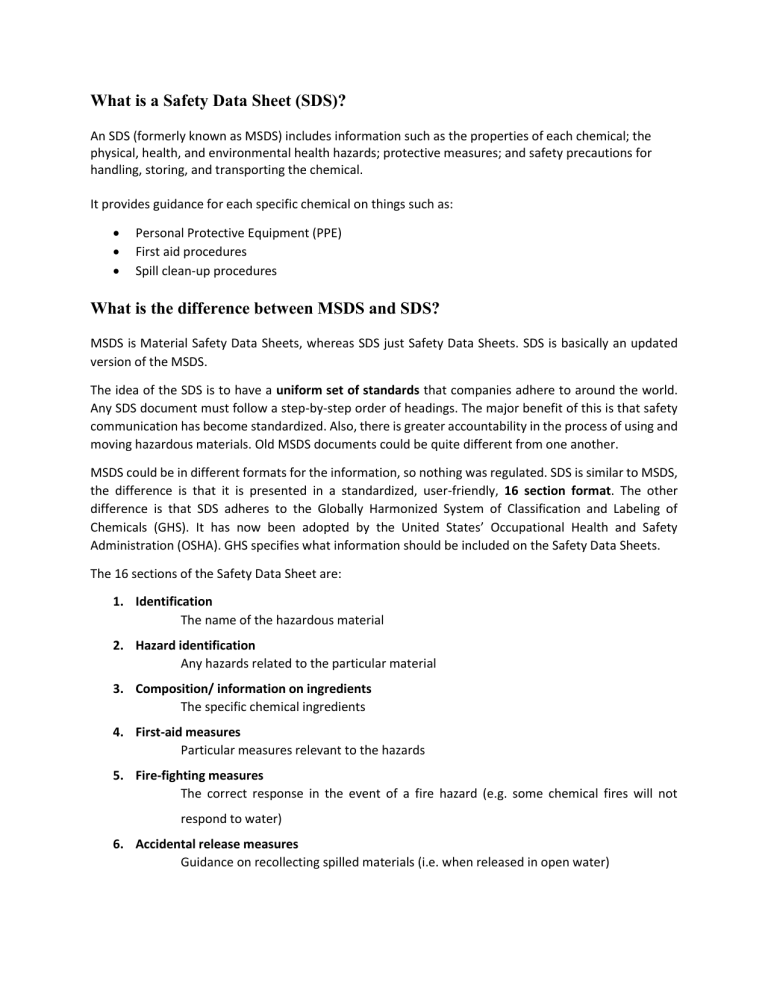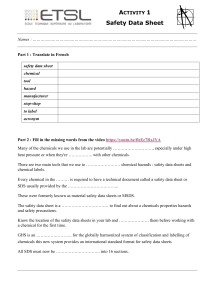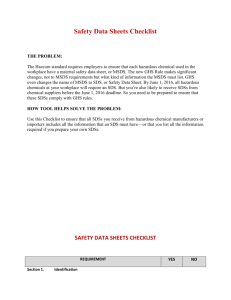
What is a Safety Data Sheet (SDS)? An SDS (formerly known as MSDS) includes information such as the properties of each chemical; the physical, health, and environmental health hazards; protective measures; and safety precautions for handling, storing, and transporting the chemical. It provides guidance for each specific chemical on things such as: Personal Protective Equipment (PPE) First aid procedures Spill clean-up procedures What is the difference between MSDS and SDS? MSDS is Material Safety Data Sheets, whereas SDS just Safety Data Sheets. SDS is basically an updated version of the MSDS. The idea of the SDS is to have a uniform set of standards that companies adhere to around the world. Any SDS document must follow a step-by-step order of headings. The major benefit of this is that safety communication has become standardized. Also, there is greater accountability in the process of using and moving hazardous materials. Old MSDS documents could be quite different from one another. MSDS could be in different formats for the information, so nothing was regulated. SDS is similar to MSDS, the difference is that it is presented in a standardized, user-friendly, 16 section format. The other difference is that SDS adheres to the Globally Harmonized System of Classification and Labeling of Chemicals (GHS). It has now been adopted by the United States’ Occupational Health and Safety Administration (OSHA). GHS specifies what information should be included on the Safety Data Sheets. The 16 sections of the Safety Data Sheet are: 1. Identification The name of the hazardous material 2. Hazard identification Any hazards related to the particular material 3. Composition/ information on ingredients The specific chemical ingredients 4. First-aid measures Particular measures relevant to the hazards 5. Fire-fighting measures The correct response in the event of a fire hazard (e.g. some chemical fires will not respond to water) 6. Accidental release measures Guidance on recollecting spilled materials (i.e. when released in open water) 7. Handling and storage Specific requirements (i.e. sunlight, temperature, etc.) 8. Exposure controls/ personal protection Necessary equipment to handle the material (i.e. gloves, glasses, etc.) 9. Physical and chemical properties Properties such as acidity, odor, viscosity, etc. 10. Stability and reactivity Known chemical interactions (i.e. oxygen or hydrogen) 11. Toxicological information Human response to ingestion and other exposure 12. Ecological information Environmental risks 13. Disposal considerations Where and how the material can be disposed of 14. Transport information Guidance on modes of transportation and related concerns 15. Regulatory information Regulations from relevant jurisdictions 16. Other information All other necessary information to prevent and mitigate the hazard



